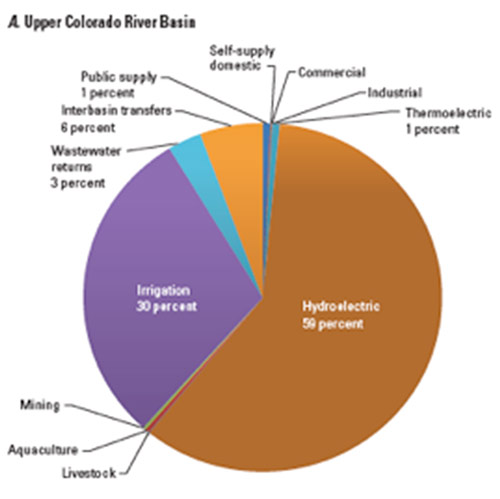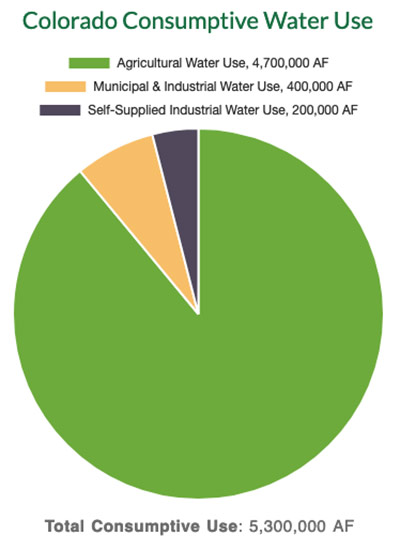The management of nonpoint sources is considered an essential part of water quality protection. If voluntary efforts are determined to be ineffective by the year 2022, more stringent regulations may be adopted…
— from the Colorado Agricultural Water Quality website maintained by Colorado State University.
I proposed yesterday, in Part Two, that many of the ’22 Ways to Care for Colorado Water’ suggested by Water Education Colorado (WECO) over the past year on their Water22.org website consist of recommendations that have almost no relationship to the actual water problem facing the American Southwest.
For example:
16. Scoop the poop and can litter
Pick up after pets to reduce the transmission of E. coli and other diseases that pollute waterways, and put all litter where it belongs – in the can.
This might be a wonderful suggestion, in terms of keeping city sidewalks and walking trail cleaner — in, say, Denver, or Boulder, or Colorado Springs — but 99.9% of Colorado’s 104,000 square miles have never seen a sidewalk or walking trail. What nearly all of Colorado has seen, meanwhile, are literally millions of mammals and birds and reptiles and fish, pooping freely wherever they please, with no one even thinking about picking up after them.
3 million cows, for example, and 1 million other livestock — and nearly all of them carry E. coli. Water22org neglects to tell us, meanwhile, that E. coli is normally a beneficial bacteria, when living within a mammal’s intestines. A human’s intestines, for example. Same goes for deer, elk, rabbits, mice, bear, mountain lions…
…the list goes on. As does the pooping.
From CDC.gov:
Escherichia coli (E. coli) bacteria normally live in the intestines of people and animals. Most E. coli are harmless and actually are an important part of a healthy human intestinal tract. However, some E. coli are pathogenic, meaning they can cause illness, either diarrhea or illness outside of the intestinal tract.
With all due respect, ‘picking up your pet’s poop’ is certainly a thoughtful practice, but it has no practical connection to Colorado’s water problems. Which is to say, the American Southwest’s water problem.
Disclosure: I currently serve on the Pagosa Area Water and Sanitation District (PAWSD) Board of Directors, but this editorial series reflects only my personal opinions, and not necessarily the opinions of the PAWSD Board as a whole.
What’s truly harmful to our water supplies? Artificial and natural fertilizers, applied carelessly. Synthetic pesticides. Sediment from improperly managed crop and forest lands and eroding streambanks. Salt from poor irrigation practices.
And we’re not talking here about the lawn in your front yard. We’re talking about 69,000 Colorado farms and ranches.
In 2012 — ten years ago — the Colorado Department of Public Health and Environment published ‘Regulation 85’, to enforce more stringent regulation of “point source” nutrient discharges, such as from wastewater treatment plants. From the Colorado State University website:
Regulation 85 does not currently regulate “nonpoint sources” of nutrient discharge, which includes most agriculture. But Regulation 85 does identify agriculture’s role in managing nutrient pollution and encourages voluntary adoption of best management practices. Future state regulations will depend on agriculture’s ability to voluntarily demonstrate commitment to water quality protection.
Let’s unpack this, by taking another look at the pie chart from the U.S. Geological Survey.
We’ve looked at this chart previously, in Parts One and Two of this editorial series, and we noted that “Public supply” — municipal water systems — account for about 1% [“one percent”] of water use in the Upper Colorado River Basin. (The ‘Upper Basin’ includes the western half of Colorado, the eastern half of Utah, plus smaller portions of Wyoming, Arizona and New Mexico.)
We also noted that “Hydroelectric” accounts for about 59% [“fifty-nine percent”] of the water use. But none of the water used for hydroelectric is ‘consumptive’. After running through the generating turbines, the water continues on down the river. The same is the case for municipal wastewater; almost all of it gets returned to the water supply following treatment.
These are ‘non-consumptive uses.’ But some municipal and industrial uses are ‘consumptive’. Watering your lawn, for example, is a consumptive use. Washing your car in your driveway is a consumptive use. Water used in fracking operations is consumptive.
This morning, we’ll talk briefly about Agriculture. The nice big 30% [“thirty percent”] slice of pie in the chart above. This water use is mainly consumptive. Most of the water used in agriculture is absorbed by crops (wheat, corn, grass and hay being significant crops in Colorado) and that water does not return to the river system. It is ‘consumed’.
The largest portion of those significant crops are fed to livestock, which account for about 70% [“seventy percent”] of agricultural sales in Colorado, according to USDA.
Here’s another pie chart, courtesy of Colorado State University, focused on ‘consumptive’ uses. The water that disappears permanently from the river system.
Agriculture accounts for 89% [“eighty-nine percent”] of the water ‘consumed’ in Colorado. Most of it goes into crops fed to livestock, generating slightly more than $5 billion in annual sales. Of that $5 billion, about $4 billion consists of cattle raised to be eaten, and another $700 million in sales of cow’s milk. That’s pretty much the whole $5 billion ball of livestock wax. Or rather, the whole water pitcher…
…used to raise cows.
What would it mean to the Colorado River, if the American West cut its beef consumption by 50%? If, instead of having a half-pound steak for dinner, we had a quarter-pound?
Or what if we skipped the steak altogether?
I think it’s a fine thing for the Colorado Water Conservation Board to spend taxpayer money on an ambitious ’22 Ways to Care for Colorado Water’ campaign, telling us to pick up pet poop.
But where’s the hard cold truth about water, and the ways we can actually address the water crisis in a meaningful way?
And what about Regulation 85? After all, it’s nearly the end of 2022. Did we forget about agriculture?


